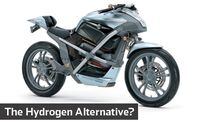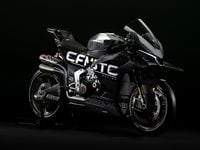Hydrogen fuel-cell electric vehicles are being touted as an alternative to plug-in electric vehicles, getting much attention in the media. But there are some important elements of this technology’s use that must be noted. First, because there is no “free” hydrogen on Earth, we must put in just as much energy to liberate it from water (and nearly as much to get it from petroleum) as we will later get back in use either to power a fuel cell (that generates electricity to move the vehicle) or for use in some form of combustion. This makes the first scenario only 50 percent efficient, and the latter only 25–35 percent efficient.
But why waste half or more of our energy in these ways? Why not use all of the electricity we make, directly?
Well, charging batteries takes time (see Electric Arrival), whereas filling a hydrogen tank either for combustion or for use in a fuel-cell vehicle (such as Suzuki's prototype Crosscage hydrogen fuel-cell two-wheeler pictured) takes minutes, just like filling a gasoline-powered motorcycle.
These technologies will compete for their place in transportation. In the meantime, gasoline from dead dinosaurs ain’t dead yet.

/cloudfront-us-east-1.images.arcpublishing.com/octane/2MZ22YFMPJD6BMT2KKI3NTX4B4.jpg)
/cloudfront-us-east-1.images.arcpublishing.com/octane/TANUCLNLT5E2NJGDVCID2FCDV4.jpg)
/cloudfront-us-east-1.images.arcpublishing.com/octane/DBI7LRMWWRGHPI5GBH6L3GHDVQ.jpg)
/cloudfront-us-east-1.images.arcpublishing.com/octane/I6JR4QBWSZF5LORDXG5MOVBA2A.jpg)
/cloudfront-us-east-1.images.arcpublishing.com/octane/ZME5GZ5TSBANFJDD6QOY3MHNSA.jpg)
/cloudfront-us-east-1.images.arcpublishing.com/octane/F7ATX3UY3NBS7JPZA7NIZRYXEU.jpg)
/cloudfront-us-east-1.images.arcpublishing.com/octane/CXO3HN354FF4HCHGJEKLVDNGZ4.jpg)


/cloudfront-us-east-1.images.arcpublishing.com/octane/7KBFBTPPJBGYDLRWU6RKX6GCRU.jpg)
/cloudfront-us-east-1.images.arcpublishing.com/octane/5YSWEJ4RCBBEXPPLUXJ7ZXPCDQ.jpg)
/cloudfront-us-east-1.images.arcpublishing.com/octane/P4A37TMJGZE2XJL4T6MRQGD5XM.jpg)
/cloudfront-us-east-1.images.arcpublishing.com/octane/VTU62CP6WRAR5JCW5U6EKWVNYI.jpg)
/cloudfront-us-east-1.images.arcpublishing.com/octane/WX4OXYW5ZBERBK3L3O4HH6WUM4.jpg)
/cloudfront-us-east-1.images.arcpublishing.com/octane/JIH63U2IABDIXLE6SOKKQDBEQY.jpg)
/cloudfront-us-east-1.images.arcpublishing.com/octane/JP3JRGOY2NEWBI5VOZZG4C6FKA.jpg)
/cloudfront-us-east-1.images.arcpublishing.com/octane/ODT6VXUIBBD2TDQCZLB45P2GGU.jpg)
/cloudfront-us-east-1.images.arcpublishing.com/octane/UCMNJ4R7ZBHE5GYCGCIERAWWPM.jpg)
/cloudfront-us-east-1.images.arcpublishing.com/octane/WS5KKTJ75VAR7PLZXS2XFRMEGQ.jpg)
/cloudfront-us-east-1.images.arcpublishing.com/octane/QEGNPZSSWJGDBGVAG2AHCDZBV4.jpg)
/cloudfront-us-east-1.images.arcpublishing.com/octane/2WHAFFD6GFGBFGXDVWUG62ZEF4.jpg)
/cloudfront-us-east-1.images.arcpublishing.com/octane/G5AKBYILZNCT7LVD5QS3OJGLIE.jpg)
/cloudfront-us-east-1.images.arcpublishing.com/octane/JYHPHUPMHZB6PI32TWTDGEZKXE.jpg)
/cloudfront-us-east-1.images.arcpublishing.com/octane/ICBZUY5IPNARHDTWXVEYPJKNLU.jpg)